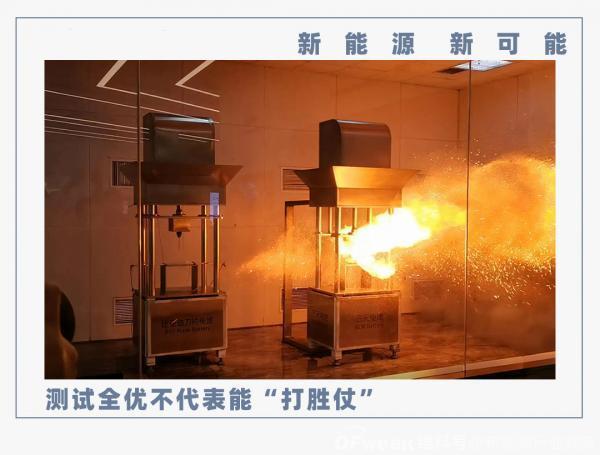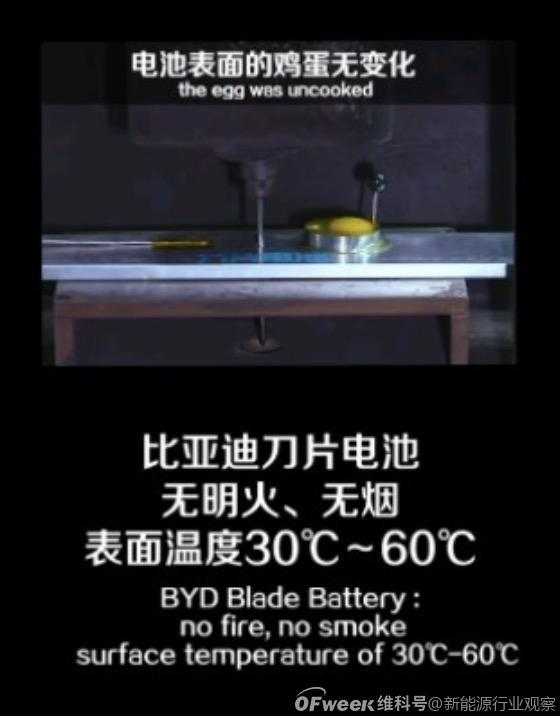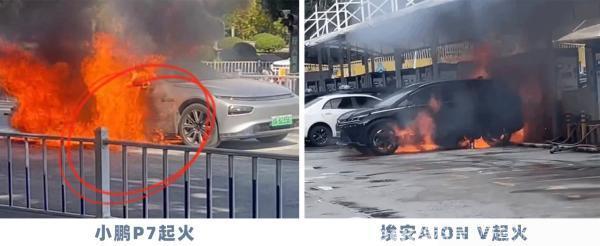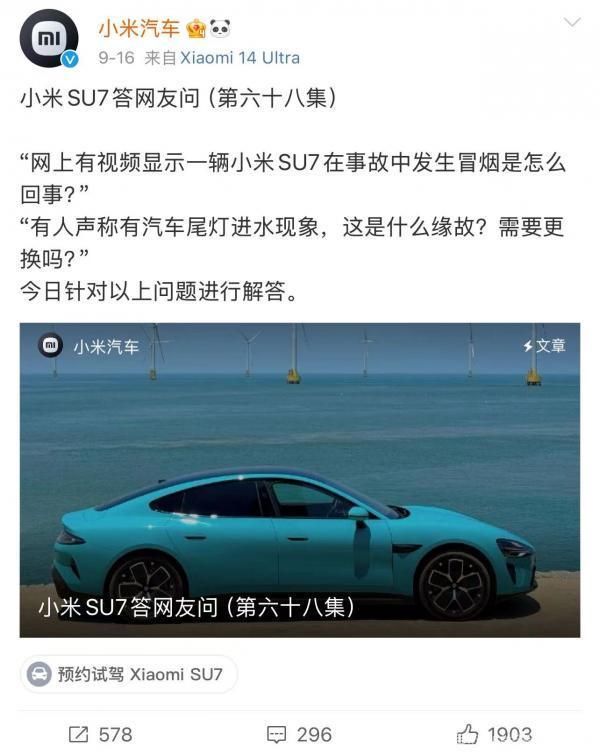Battery puncture test, just a futile effort, piercing the hearts of consumers
![]() 09/22 2024
09/22 2024
![]() 376
376

New Energy Perspective (ID: xinnengyuanqianzhan) Original
Recently, the news of "Xiaomi SU7 smoking and catching fire" hit the trending topics. The fuse for this fire incident stemmed from a local short circuit after the battery bottom was damaged.
Immediately afterward, Xiaomi's official response successfully reassured most consumers. However, it is crucial to note that reassurance does not equate to addressing concerns, and preventing such accidents from happening again is the optimal solution.
Within just two months, the base model of Xiaomi SU7 equipped with BYD Fudi batteries has experienced two smoking and fire incidents. The topic of "battery safety," an inherent concern in new energy vehicles, has once again ignited the internet. How can the trust barrier between consumers and automakers be eliminated? This requires automakers and battery manufacturers to "do more than just talk."
1. Strong data, but fails in real-world tests?
Currently, battery suppliers often conduct public tests on safety, stability, and endurance before mass-producing batteries for vehicles to demonstrate their product capabilities and build trust with consumers.
As early as 2020, at the launch of BYD's Blade Battery, to prove their commitment to erasing "spontaneous combustion" from the dictionary of electric vehicles, BYD publicly demonstrated the blade battery nail penetration test. According to the test results, BYD's LFP (Lithium Iron Phosphate) Blade Battery remained without flame, smoke, and with a surface temperature of 30-60°C even after a 20-minute nail penetration test.

Image/Blade Battery Nail Penetration Test
Source/Internet Screenshot from New Energy Perspective
At the time, consumers had high expectations for the Blade Battery.
As the saying goes, ideals are abundant, but reality is often harsh. When the Blade Battery, supported by "impressive" test data, was put into real-world use, its "magic" seemed to fade, with repeated incidents of static spontaneous combustion or battery pack punctures and fires after vehicle collisions.
Mr. Xu, a BYD Han owner (pseudonym), complained after seeing a similar vehicle catch fire statically, "I don't know much about electric car batteries. I chose a new energy vehicle because electricity is cheaper than gasoline. I chose BYD because of its high sales and the battery test data they published, but I never expected the car I bought to be so unsafe."
In our interactions with New Energy Perspective, several consumers expressed that they purchased certain car models based on the automakers' public battery test results, but the outcomes were unsatisfactory.
It's worth noting that BYD is not the only automaker emphasizing battery promotion. Many other automakers, such as GAC Aion and XPeng, have also publicly disclosed their battery test data.
Based on the publicly available test results, the batteries used by these automakers offer significant safety guarantees. For instance, XPeng's Zhongchuanghang ternary lithium-ion batteries and GAC Aion's battery packs have shown no signs of fire or explosion during nail penetration tests.
However, when these batteries with impressive test results are put into real-world use, they seem to fall short. For example, from January to September 2023, there were seven spontaneous combustion incidents involving XPeng P7; in August 2024, a GAC Aion AION V caught fire while charging in Shenzhen, resulting in an explosion within seconds.

Image/XPeng, Aion Fires
Source/Internet Screenshot from New Energy Perspective
Thus, few new energy automakers, including BYD, can accurately align their battery performance in real-world feedback with test data.
Consumers have questioned why batteries with near-perfect test results fail in real-world use.
Firstly, it's essential to understand that automakers' battery test data is based on specific environmental and testing conditions, which may not perfectly mimic real-world scenarios influenced by factors like temperature, humidity, and battery wear and tear. Secondly, real-world vehicle use involves variables such as driving habits, vehicle load, and road conditions.
It's evident that automakers tend to showcase the positive aspects of their products during promotion, which explains why some batteries with good test results may underperform in real-world use.
2. The winning formula: strive to be the "floor-sweeping monk"
It's no exaggeration to say that as competition in the new energy sector intensifies, the level of battery testing has reached new heights. Tailor-made "hellish tests" like high-temperature exposure, high-altitude drops, seawater immersion, and nail penetration have emerged in abundance.
While disclosing test data to consumers is beneficial for automakers to enhance their brand image and recognition, it's crucial not to overlook the importance of aligning test data with real-world performance. Over time, failing to do so can erode consumer trust. Ultimately, real-world performance carries more weight than test results when it comes to safeguarding lives and property.
Wei Jianjun, Chairman of Great Wall Motor, once stated, "Some industry leaders are now advocating for improper, unfair, and fraudulent competition."
Taking BYD as an example, which accounted for approximately 16% of fire incidents among China's new energy vehicle brands from January to September 2023, the company consistently showcases impressive test data on its Blade Battery but has struggled with real-world performance.
Visitors to auto shows have likely seen BYD's "nail penetration test" setups, demonstrating the stability of its batteries. However, BYD's spontaneous combustion incidents have persisted. In April, a BYD Han caught fire while being transported on a semi-trailer; in May, a BYD dealership in Fuzhou, Fujian, burned down, leaving only the building's skeleton standing.

Image/BYD Han - BYD Dealership Fire
Source/Internet Screenshot from New Energy Perspective
When considering purchasing an electric car, Liu Ke (pseudonym) ruled out BYD as her first choice. In her words, "Impressive test data can't fill your stomach. I wouldn't touch a brand that can catch fire at rest." She added, "After seeing too many such news, I sometimes develop a conditioned reflex and want to stay away from models with frequent spontaneous combustion incidents."
To sustain their market position, new energy automakers must not only disclose test data before mass production but also focus on real-world performance, creating batteries that can withstand real-world challenges. As the primary power source of electric vehicles, batteries are undeniably crucial.
So, how can automakers develop batteries with performance matching their promotional claims? The answer lies in in-depth research into materials, structure, and manufacturing processes. Lithium-ion batteries inherently possess physical and chemical properties that pose potential risks. However, if manufacturers can reduce cell failure rates from the current average of one in a million to one in a billion, that would represent a significant leap forward.
The pursuit of safety is never-ending. Consumer needs are the lifeblood of any business.
Consumers and businesses are like water and a boat; businesses must genuinely respect consumers. Xiaomi's timely response to the incident effectively defused the crisis.

Image/Xiaomi's Official Response to Fire Incident
Source/Xiaomi Auto Official Weibo Screenshot from New Energy Perspective
In contrast, BYD has rarely addressed societal concerns directly, whether it's spontaneous combustion during collisions, static conditions, or dealership fires. Even in last year's fatal BYD Han collision on the Baomao Expressway, the victim's family stated that BYD seemed to have vanished, refusing to cooperate with police investigations.
Such indifference and arrogance are hardly befitting a great national enterprise and undermine its ability to fulfill consumer expectations.
Water can carry a boat or capsize it. In the upcoming new energy "gamble," only those who prioritize real-world performance over promotion and genuinely prioritize consumer safety will prevail, regardless of their current size or status.








